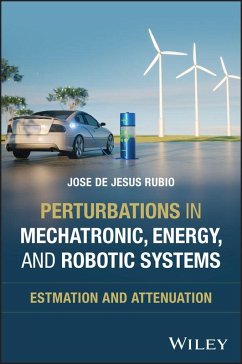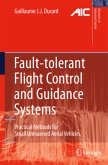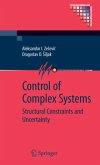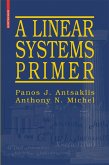Jose de Jesus Rubio
Perturbations in Mechatronic, Energy, and Robotic Systems
Estimation and Attenuation
Jose de Jesus Rubio
Perturbations in Mechatronic, Energy, and Robotic Systems
Estimation and Attenuation
- Gebundenes Buch
Andere Kunden interessierten sich auch für
![Fault-tolerant Flight Control and Guidance Systems Fault-tolerant Flight Control and Guidance Systems]() Guillaume J. J. DucardFault-tolerant Flight Control and Guidance Systems113,99 €
Guillaume J. J. DucardFault-tolerant Flight Control and Guidance Systems113,99 €![Parallel Robotic Machine Tools Parallel Robotic Machine Tools]() Dan ZhangParallel Robotic Machine Tools113,99 €
Dan ZhangParallel Robotic Machine Tools113,99 €![Discontinuous Systems Discontinuous Systems]() Yury V OrlovDiscontinuous Systems113,99 €
Yury V OrlovDiscontinuous Systems113,99 €![Control of Complex Systems Control of Complex Systems]() Aleksandar ZecevicControl of Complex Systems76,99 €
Aleksandar ZecevicControl of Complex Systems76,99 €![Control of Complex Systems Control of Complex Systems]() Aleksandar ZecevicControl of Complex Systems76,99 €
Aleksandar ZecevicControl of Complex Systems76,99 €![Efficient Modeling and Control of Large-Scale Systems Efficient Modeling and Control of Large-Scale Systems]() Efficient Modeling and Control of Large-Scale Systems113,99 €
Efficient Modeling and Control of Large-Scale Systems113,99 €![A Linear Systems Primer A Linear Systems Primer]() Panos J AntsaklisA Linear Systems Primer68,99 €
Panos J AntsaklisA Linear Systems Primer68,99 €-
-
-
Produktdetails
- Verlag: Wiley
- Seitenzahl: 272
- Erscheinungstermin: 17. März 2026
- Englisch
- ISBN-13: 9781394380633
- ISBN-10: 1394380631
- Artikelnr.: 74964393
- Herstellerkennzeichnung
- Libri GmbH
- Europaallee 1
- 36244 Bad Hersfeld
- gpsr@libri.de
Contents
1 Geometric approach and structure at infinity controls for the
perturbation attenuation
1.1 Introduction
1.2 Notation
1.3 Perturbation attenuation problem
1.4 Perturbation attenuation via geometric approach control
1.5 Perturbation attenuation via structure at infinity control
1.6 Mechanical system
1.6.1 The states space system
1.6.2 Perturbation attenuation via the structure at infinity control
1.6.3 Perturbation attenuation via the geometric approach control
1.6.4 Simulation
1.7 Thermal system
1.7.1 Perturbation attenuation via the structure at in...nity control
1.7.2 Perturbation attenuation via the geometric approach control
1.7.3 Simulation
1.8 Concluding remarks
2 Structure control for the perturbation attenuation in two
electromechanical processes
2.1 Introduction
2.2 Structure at infinity method for the perturbation attenuation
2.3 Structure control for the perturbation attenuation
2.3.1 Controller design
2.3.2 Stability analysis
2.3.3 Convergence analysis
2.4 Perturbation attenuation in a three phase electric circuit
2.4.1 Structure at in...nity control design
2.4.2 Structure control design
2.4.3 Results
2.5 Perturbation attenuation in a plotter
2.5.1 Structure at in...nity control design
2.5.2 Structure control design
2.5.3 Results
2.6 Concluding remarks
3 Hybrid controller with observer for the estimation and attenuation of
per-turbations
3.1 Introduction
3.2 The perturbed system
3.3 Hybrid observer
3.3.1 Observer design
3.3.2 Stability analysis
3.3.3 Estimation of the perturbations
3.4 Hybrid controller with observer
3.4.1 Controller design
3.4.2 Stability analysis
3.5 Plotter system
3.6 Suspension system
3.7 Concluding remarks
4 Sliding mode regulator for the perturbations attenuation in two tank
plants
4.1 Introduction
4.2 The perturbed plant
4.3 The sliding mode regulator
4.3.1 The regulator development
4.3.2 The stability analysis
4.4 The thermal plan
4.5 The hydraulic plant
4.6 Concluding remarks
5 Uniform stable observer for the perturbation estimation in two renewable
energy systems
5.1 Introduction
5.2 Observer for the systems without perturbations
5.2.1 Observer design
5.2.2 Stability analysis of the observer
5.3 Observer for the systems with perturbations
5.3.1 Observer design
5.3.2 Stability analysis of the observer
5.3.3 Convergence analysis of the observer
5.3.4 Estimation of the perturbations
5.4 Wind turbine
5.4.1 Results
5.5 Electric vehicle
5.5.1 Results
5.6 Concluding remarks
6 The perturbation estimation in two gas plants
6.1 Introduction
6.2 The estimator for the variable and perturbation estimation
6.2.1 The variable estimator
6.2.2 The convergence analysis of the variable estimator
6.2.3 The perturbations estimator
6.3 The gas turbine plant
6.3.1 Results
6.4 The gasi...cation plant
6.4.1 Results
6.5 Concluding remarks
7 Stabilization of two electricity generators with dead-zone
7.1 Introduction
7.2 Mathematical model and regulators for the electricity generators with
dead-zone
7.3 Sliding mode regulator with sine mapping
7.4 Simulations
7.4.1 Electricity generators with dead-zone with two static magnets and two
dynamic magnets
7.4.2 Electricity generators with dead-zone with four static magnets and
four dynamic magnets
7.5 Concluding remarks
8 A control to attenuate the perturbations and to stabilize the rotatory
in-verted pendulum
8.1 Introduction
8.2 Rotary inverted pendulum
8.3 The problem of stabilization for the pole placement method
8.4 The problem of perturbation attenuation
8.5 Stable control which attenuate the perturbations for the rotatory
inverted pendulum
8.5.1 Stability analysis of the system
8.5.2 Controllability of the system
8.5.3 Control design
8.6 Simulation
8.7 Concluding remarks
9 Proportional derivative control with inverse dead-zone for pendulum
systems
9.1 Introduction
9.2 Dynamic model of the robotic arms with dead-zone input
9.3 Dynamic model of the pendulum systems with dead-zone inputs
9.4 Proportional derivative control with inverse dead-zone
9.5 Simulations
9.5.1 Example 1
9.5.2 Example 2
9.6 Concluding remarks
10 Sliding mode control of robotic arms with dead-zone
10.1 Introduction
10.2 Dynamic model of robotic arms with dead-zone and gravity
10.3 Sliding mode control for the regulation of robotic arms with dead-zone
and gravity
10.4 Results
10.4.1 Transelevator
10.4.2 Articulated robotic arm
10.5 Concluding remarks
1 Geometric approach and structure at infinity controls for the
perturbation attenuation
1.1 Introduction
1.2 Notation
1.3 Perturbation attenuation problem
1.4 Perturbation attenuation via geometric approach control
1.5 Perturbation attenuation via structure at infinity control
1.6 Mechanical system
1.6.1 The states space system
1.6.2 Perturbation attenuation via the structure at infinity control
1.6.3 Perturbation attenuation via the geometric approach control
1.6.4 Simulation
1.7 Thermal system
1.7.1 Perturbation attenuation via the structure at in...nity control
1.7.2 Perturbation attenuation via the geometric approach control
1.7.3 Simulation
1.8 Concluding remarks
2 Structure control for the perturbation attenuation in two
electromechanical processes
2.1 Introduction
2.2 Structure at infinity method for the perturbation attenuation
2.3 Structure control for the perturbation attenuation
2.3.1 Controller design
2.3.2 Stability analysis
2.3.3 Convergence analysis
2.4 Perturbation attenuation in a three phase electric circuit
2.4.1 Structure at in...nity control design
2.4.2 Structure control design
2.4.3 Results
2.5 Perturbation attenuation in a plotter
2.5.1 Structure at in...nity control design
2.5.2 Structure control design
2.5.3 Results
2.6 Concluding remarks
3 Hybrid controller with observer for the estimation and attenuation of
per-turbations
3.1 Introduction
3.2 The perturbed system
3.3 Hybrid observer
3.3.1 Observer design
3.3.2 Stability analysis
3.3.3 Estimation of the perturbations
3.4 Hybrid controller with observer
3.4.1 Controller design
3.4.2 Stability analysis
3.5 Plotter system
3.6 Suspension system
3.7 Concluding remarks
4 Sliding mode regulator for the perturbations attenuation in two tank
plants
4.1 Introduction
4.2 The perturbed plant
4.3 The sliding mode regulator
4.3.1 The regulator development
4.3.2 The stability analysis
4.4 The thermal plan
4.5 The hydraulic plant
4.6 Concluding remarks
5 Uniform stable observer for the perturbation estimation in two renewable
energy systems
5.1 Introduction
5.2 Observer for the systems without perturbations
5.2.1 Observer design
5.2.2 Stability analysis of the observer
5.3 Observer for the systems with perturbations
5.3.1 Observer design
5.3.2 Stability analysis of the observer
5.3.3 Convergence analysis of the observer
5.3.4 Estimation of the perturbations
5.4 Wind turbine
5.4.1 Results
5.5 Electric vehicle
5.5.1 Results
5.6 Concluding remarks
6 The perturbation estimation in two gas plants
6.1 Introduction
6.2 The estimator for the variable and perturbation estimation
6.2.1 The variable estimator
6.2.2 The convergence analysis of the variable estimator
6.2.3 The perturbations estimator
6.3 The gas turbine plant
6.3.1 Results
6.4 The gasi...cation plant
6.4.1 Results
6.5 Concluding remarks
7 Stabilization of two electricity generators with dead-zone
7.1 Introduction
7.2 Mathematical model and regulators for the electricity generators with
dead-zone
7.3 Sliding mode regulator with sine mapping
7.4 Simulations
7.4.1 Electricity generators with dead-zone with two static magnets and two
dynamic magnets
7.4.2 Electricity generators with dead-zone with four static magnets and
four dynamic magnets
7.5 Concluding remarks
8 A control to attenuate the perturbations and to stabilize the rotatory
in-verted pendulum
8.1 Introduction
8.2 Rotary inverted pendulum
8.3 The problem of stabilization for the pole placement method
8.4 The problem of perturbation attenuation
8.5 Stable control which attenuate the perturbations for the rotatory
inverted pendulum
8.5.1 Stability analysis of the system
8.5.2 Controllability of the system
8.5.3 Control design
8.6 Simulation
8.7 Concluding remarks
9 Proportional derivative control with inverse dead-zone for pendulum
systems
9.1 Introduction
9.2 Dynamic model of the robotic arms with dead-zone input
9.3 Dynamic model of the pendulum systems with dead-zone inputs
9.4 Proportional derivative control with inverse dead-zone
9.5 Simulations
9.5.1 Example 1
9.5.2 Example 2
9.6 Concluding remarks
10 Sliding mode control of robotic arms with dead-zone
10.1 Introduction
10.2 Dynamic model of robotic arms with dead-zone and gravity
10.3 Sliding mode control for the regulation of robotic arms with dead-zone
and gravity
10.4 Results
10.4.1 Transelevator
10.4.2 Articulated robotic arm
10.5 Concluding remarks
Contents
1 Geometric approach and structure at infinity controls for the
perturbation attenuation
1.1 Introduction
1.2 Notation
1.3 Perturbation attenuation problem
1.4 Perturbation attenuation via geometric approach control
1.5 Perturbation attenuation via structure at infinity control
1.6 Mechanical system
1.6.1 The states space system
1.6.2 Perturbation attenuation via the structure at infinity control
1.6.3 Perturbation attenuation via the geometric approach control
1.6.4 Simulation
1.7 Thermal system
1.7.1 Perturbation attenuation via the structure at in...nity control
1.7.2 Perturbation attenuation via the geometric approach control
1.7.3 Simulation
1.8 Concluding remarks
2 Structure control for the perturbation attenuation in two
electromechanical processes
2.1 Introduction
2.2 Structure at infinity method for the perturbation attenuation
2.3 Structure control for the perturbation attenuation
2.3.1 Controller design
2.3.2 Stability analysis
2.3.3 Convergence analysis
2.4 Perturbation attenuation in a three phase electric circuit
2.4.1 Structure at in...nity control design
2.4.2 Structure control design
2.4.3 Results
2.5 Perturbation attenuation in a plotter
2.5.1 Structure at in...nity control design
2.5.2 Structure control design
2.5.3 Results
2.6 Concluding remarks
3 Hybrid controller with observer for the estimation and attenuation of
per-turbations
3.1 Introduction
3.2 The perturbed system
3.3 Hybrid observer
3.3.1 Observer design
3.3.2 Stability analysis
3.3.3 Estimation of the perturbations
3.4 Hybrid controller with observer
3.4.1 Controller design
3.4.2 Stability analysis
3.5 Plotter system
3.6 Suspension system
3.7 Concluding remarks
4 Sliding mode regulator for the perturbations attenuation in two tank
plants
4.1 Introduction
4.2 The perturbed plant
4.3 The sliding mode regulator
4.3.1 The regulator development
4.3.2 The stability analysis
4.4 The thermal plan
4.5 The hydraulic plant
4.6 Concluding remarks
5 Uniform stable observer for the perturbation estimation in two renewable
energy systems
5.1 Introduction
5.2 Observer for the systems without perturbations
5.2.1 Observer design
5.2.2 Stability analysis of the observer
5.3 Observer for the systems with perturbations
5.3.1 Observer design
5.3.2 Stability analysis of the observer
5.3.3 Convergence analysis of the observer
5.3.4 Estimation of the perturbations
5.4 Wind turbine
5.4.1 Results
5.5 Electric vehicle
5.5.1 Results
5.6 Concluding remarks
6 The perturbation estimation in two gas plants
6.1 Introduction
6.2 The estimator for the variable and perturbation estimation
6.2.1 The variable estimator
6.2.2 The convergence analysis of the variable estimator
6.2.3 The perturbations estimator
6.3 The gas turbine plant
6.3.1 Results
6.4 The gasi...cation plant
6.4.1 Results
6.5 Concluding remarks
7 Stabilization of two electricity generators with dead-zone
7.1 Introduction
7.2 Mathematical model and regulators for the electricity generators with
dead-zone
7.3 Sliding mode regulator with sine mapping
7.4 Simulations
7.4.1 Electricity generators with dead-zone with two static magnets and two
dynamic magnets
7.4.2 Electricity generators with dead-zone with four static magnets and
four dynamic magnets
7.5 Concluding remarks
8 A control to attenuate the perturbations and to stabilize the rotatory
in-verted pendulum
8.1 Introduction
8.2 Rotary inverted pendulum
8.3 The problem of stabilization for the pole placement method
8.4 The problem of perturbation attenuation
8.5 Stable control which attenuate the perturbations for the rotatory
inverted pendulum
8.5.1 Stability analysis of the system
8.5.2 Controllability of the system
8.5.3 Control design
8.6 Simulation
8.7 Concluding remarks
9 Proportional derivative control with inverse dead-zone for pendulum
systems
9.1 Introduction
9.2 Dynamic model of the robotic arms with dead-zone input
9.3 Dynamic model of the pendulum systems with dead-zone inputs
9.4 Proportional derivative control with inverse dead-zone
9.5 Simulations
9.5.1 Example 1
9.5.2 Example 2
9.6 Concluding remarks
10 Sliding mode control of robotic arms with dead-zone
10.1 Introduction
10.2 Dynamic model of robotic arms with dead-zone and gravity
10.3 Sliding mode control for the regulation of robotic arms with dead-zone
and gravity
10.4 Results
10.4.1 Transelevator
10.4.2 Articulated robotic arm
10.5 Concluding remarks
1 Geometric approach and structure at infinity controls for the
perturbation attenuation
1.1 Introduction
1.2 Notation
1.3 Perturbation attenuation problem
1.4 Perturbation attenuation via geometric approach control
1.5 Perturbation attenuation via structure at infinity control
1.6 Mechanical system
1.6.1 The states space system
1.6.2 Perturbation attenuation via the structure at infinity control
1.6.3 Perturbation attenuation via the geometric approach control
1.6.4 Simulation
1.7 Thermal system
1.7.1 Perturbation attenuation via the structure at in...nity control
1.7.2 Perturbation attenuation via the geometric approach control
1.7.3 Simulation
1.8 Concluding remarks
2 Structure control for the perturbation attenuation in two
electromechanical processes
2.1 Introduction
2.2 Structure at infinity method for the perturbation attenuation
2.3 Structure control for the perturbation attenuation
2.3.1 Controller design
2.3.2 Stability analysis
2.3.3 Convergence analysis
2.4 Perturbation attenuation in a three phase electric circuit
2.4.1 Structure at in...nity control design
2.4.2 Structure control design
2.4.3 Results
2.5 Perturbation attenuation in a plotter
2.5.1 Structure at in...nity control design
2.5.2 Structure control design
2.5.3 Results
2.6 Concluding remarks
3 Hybrid controller with observer for the estimation and attenuation of
per-turbations
3.1 Introduction
3.2 The perturbed system
3.3 Hybrid observer
3.3.1 Observer design
3.3.2 Stability analysis
3.3.3 Estimation of the perturbations
3.4 Hybrid controller with observer
3.4.1 Controller design
3.4.2 Stability analysis
3.5 Plotter system
3.6 Suspension system
3.7 Concluding remarks
4 Sliding mode regulator for the perturbations attenuation in two tank
plants
4.1 Introduction
4.2 The perturbed plant
4.3 The sliding mode regulator
4.3.1 The regulator development
4.3.2 The stability analysis
4.4 The thermal plan
4.5 The hydraulic plant
4.6 Concluding remarks
5 Uniform stable observer for the perturbation estimation in two renewable
energy systems
5.1 Introduction
5.2 Observer for the systems without perturbations
5.2.1 Observer design
5.2.2 Stability analysis of the observer
5.3 Observer for the systems with perturbations
5.3.1 Observer design
5.3.2 Stability analysis of the observer
5.3.3 Convergence analysis of the observer
5.3.4 Estimation of the perturbations
5.4 Wind turbine
5.4.1 Results
5.5 Electric vehicle
5.5.1 Results
5.6 Concluding remarks
6 The perturbation estimation in two gas plants
6.1 Introduction
6.2 The estimator for the variable and perturbation estimation
6.2.1 The variable estimator
6.2.2 The convergence analysis of the variable estimator
6.2.3 The perturbations estimator
6.3 The gas turbine plant
6.3.1 Results
6.4 The gasi...cation plant
6.4.1 Results
6.5 Concluding remarks
7 Stabilization of two electricity generators with dead-zone
7.1 Introduction
7.2 Mathematical model and regulators for the electricity generators with
dead-zone
7.3 Sliding mode regulator with sine mapping
7.4 Simulations
7.4.1 Electricity generators with dead-zone with two static magnets and two
dynamic magnets
7.4.2 Electricity generators with dead-zone with four static magnets and
four dynamic magnets
7.5 Concluding remarks
8 A control to attenuate the perturbations and to stabilize the rotatory
in-verted pendulum
8.1 Introduction
8.2 Rotary inverted pendulum
8.3 The problem of stabilization for the pole placement method
8.4 The problem of perturbation attenuation
8.5 Stable control which attenuate the perturbations for the rotatory
inverted pendulum
8.5.1 Stability analysis of the system
8.5.2 Controllability of the system
8.5.3 Control design
8.6 Simulation
8.7 Concluding remarks
9 Proportional derivative control with inverse dead-zone for pendulum
systems
9.1 Introduction
9.2 Dynamic model of the robotic arms with dead-zone input
9.3 Dynamic model of the pendulum systems with dead-zone inputs
9.4 Proportional derivative control with inverse dead-zone
9.5 Simulations
9.5.1 Example 1
9.5.2 Example 2
9.6 Concluding remarks
10 Sliding mode control of robotic arms with dead-zone
10.1 Introduction
10.2 Dynamic model of robotic arms with dead-zone and gravity
10.3 Sliding mode control for the regulation of robotic arms with dead-zone
and gravity
10.4 Results
10.4.1 Transelevator
10.4.2 Articulated robotic arm
10.5 Concluding remarks








